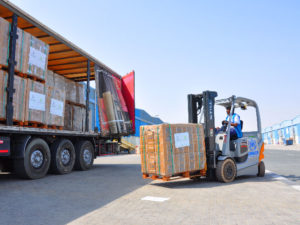Tripling Warehousing Space To Meet Sharp Rise In Global Demand For Emergency Aid Worldwide
A massive plan to triple the size of the UAE-based International Humanitarian City (IHC), including warehousing space, are hoped to allow the world’s largest humanitarian logistics hub and its member United Nations aid agencies and NGOs respond more efficiently to several crises and disasters simultaneously to meet a sharp rise in global demand for emergency aid, IHC’s incoming Chief Executive Officer Giuseppe Saba said today in an exclusive interview with Emirates News Agency (WAM).
The fact that in the past four years IHC has received a massive demand from the humanitarian community represented by the UN and NGO agencies, struggling to cope with the sharp rise in emergencies, justifies the massive expansion of the IHC to 360,000 square meters of warehousing facilities, that was announced in December 2016, and approved by Vice President, Prime Minister and Ruler of Dubai, His Highness Sheikh Mohammed bin Rashid Al Maktoum, in January, according to Saba, a logistics pioneer and former head of the United Nation’s Humanitarian Response Depots (UNHRD).
“A few years ago, IHC underwent its first tripling in size, up to the current 105,000 square meter space in the Dubai Industrial City. The total number of shipments delivered for emergency responses by IHC’s members from 2011 to 2016 climbed to 8,211 worth AED 2.298 billion – $625.9 million. In addition to this, from 2009 to2014, IHC’s humanitarian impact has increased by 87 per cent,” Saba told WAM.
These statistics, he stressed, affirm H.H. Sheikh Mohammed bin Rashid’s’ vision in establishing the UAE as a hub for providing humanitarian aid in emergencies and for disaster relief, through securing the logistic infrastructure, facilities, and services required to enable its members to achieve their objectives across the globe.
“The continuing rise in demand, along with UAE’s strategic location, serving two thirds of the world’s population and the highest risk geographical areas, justify the need to triple the IHC’s size once again,” Saba said.
To help its members meet their immediate growth needs, IHC will expand the current facilities by an additional 20 per cent (20,000 square meters), to reach 120,000 square meters of storage space. It will then embark on the broader expansion plan, which will result in tripling the size of the IHC a second time to reach 360,000 square meters.
In December, HRH Princess Haya bint Al Hussein, Chairwoman of IHC, and wife of H.H. Sheikh Mohammed bin Rashid, said the expansion plan comes as the IHC, the only humanitarian free zone in the world, has grown to host 9 UN humanitarian agencies, and over 50 international non-profit organisations, intergovernmental organisations and commercial companies.
In June 2016, under the guidance of H.H. Sheikh Mohammed bin Rashid, HRH Princess Haya and the IHC Board began a phase of addressing the internal structure of the organisation in order to expand the IHC operations and reach.
An Executive Committee was appointed with HRH Princess Haya as Chairwoman.
WAM-MMYS The following is the full text of WAM’s interview with Giuseppe Saba, the incoming Chief Executive Officer of IHC.
——————- H.H. Sheikh Mohammed bin Rashid Al Maktoum recently announced he will triple the size of the International Humanitarian City, up to 360,000 square meters, why such a massive expansion? A few years ago, IHC underwent its first tripling in size, up to the current 105,000 square meter space in the Dubai Industrial City. In the past four years, IHC has received a massive demand from the humanitarian community represented by the UN and NGO agencies, trying to cope with the sharp rise in emergencies. The total number of shipments delivered for emergency responses by IHC’s members from 2011 to 2016 climbed to 8,211 worth AED 2,298 billion – $625.9 million. In addition to this, from 2009-2014, IHC’s humanitarian impact has increased by 87 per cent. These statistics affirm His Highness’ vision in establishing the UAE as a hub for providing humanitarian aid in emergency situations and for disaster relief, through securing the logistic infrastructure, facilities, and services required to enable its members to achieve their objectives across the globe. The continuing rise in demand, along with UAE’s strategic location, serving two thirds of the world’s population and the highest risk geographical areas, justify the need to triple the IHC’s size once again.
————————————————————————————————————————————- The current demand for space is immediate, while the expansion will take some time; how will IHC support its members in the immediate period? To help its members meet their immediate growth needs, IHC will expand the current facilities by an additional 20 per cent (20,000 square meters), to reach 120,000 square meters of storage space. It will then embark on the broader expansion plan, which will result in tripling the size of the IHC a second time to reach 360,000 square meters. The plot that will be used for this expansion is located in the Al Maktoum airport area and in proximity to the port of Jebel Ali and the EXPO 2020.
————————————————————————————————————————————– How will the expansion plan be developed and what are the priorities? The expansion plan should go through phases. Tentatively the first one should be finalised by 2020. It will include the design of a master-plan and a construction plan of the new IHC plot of Land and the construction of the first lot of warehouses, new office spaces, center of excellence for trainings, permanent exhibition and innovation lab, and simulation areas that can enable IHC’s members to perform capacity building activities and to continue to promote education in the humanitarian field.
Phase 2 (2020 – 2022) will include the development of the second lot of warehouses and additional amenities, which shall complete the new City Simultaneously, IHC will also embark on activities with its members to re-enforce its top position in humanitarian response worldwide and promote links and dialogue with other humanitarian logistics centers, thus creating synergies and improving the efficiency of responses to demand for both emergency and development aid —————————————————————————————————————- How fast are IHC members responding to humanitarian emergencies and how the UAE is helping them? The humanitarian emergency response is crucial for saving life and the response can be more efficient if there is a good level of preparedness behind it. IHC provides such preparedness and we intend to support our members in the critical preparation phase of a crisis. The humanitarian strategic stocks pre-positioned by our members within IHC are survival items and need appropriate space and professional management. The recent pandemic situations of Ebola, SARS and avian flu are pressing the humanitarian organisations for increasing preparedness, and Dubai, a part of the UAE, with its strategic position, plays a crucial role.
The IHC has played a pivotal role in providing the first and fastest responses to crises in places as far away as Haiti and Vanuatu, but is especially critical in moving goods to trouble spots in the MENA region and East Africa. Important International relief responses include Hurricane Matthew in Haiti (2016) where 90 metric tonnes of aid worth $361,000 were sent benefiting more than 339,500 people. Prior to this, IHC also assisted during the Haiti Earthquake in 2010, where 90 metric tonnes of aid was sent on donated Boeing 747 worth $500,000 and 21 Arab nationals were evacuated. Regionally, IHC responded to various emergencies, including one in Gaza Strip in 2014 by moving $7 million worth of relief items within 36 hours of the emergency.
IHC strength has not been limited to delivering aid, but also to evacuating its member’s staff in a very efficient manner. For example, IHC evacuated 200 UNDP staff in 3 hours Afghanistan (2009); 45 WHO staff members in Egypt in 2011 and 483 UN staff from WFP, UNHCR, UNICEF and UNDP within 36 hours from Yemen in 2011, 2014, and 2015.
For more information, visit ihc.ae







